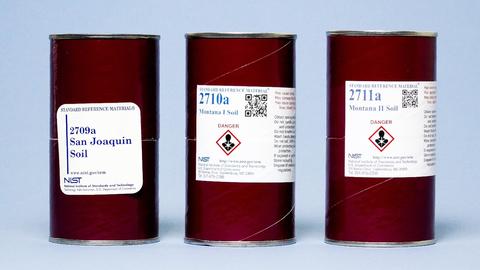Summary
Analysis of soils for metals and other elements is essential in assessing environmental compliance and the impacts of potentially toxic elements on human, animal, and plant health. In 1991, NIST provided a suite of three soil SRMs covering a wide range of concentrations for total element content. NIST also provided tabulated results from laboratories using USEPA methods for acid extraction of metals of concern. The large number of assigned values, the results obtained by using EPA methods, and the wide elemental concentration ranges represented by this suite of soils have resulted in an extremely high demand for these SRMs in the U.S. and worldwide. This SRM suite is being renewed so that NIST may continue to meet the needs of the environmental and agricultural science communities.
Description

Standard Reference Materials for inorganic environmental measurements.
The three NIST soil SRMs, 2709, 2710 and 2711, have been used worldwide by hundreds of laboratories; combined sales typically exceed 800 units per year. Use of these SRMs provides our customers with tools that are essential for achieving quality assurance in the analysis of contaminant elements in soils, assuring environmental compliance, and validation of data for assessments of the impacts of metals on human, animal, and plant health.
Major Accomplishments
- Three soil SRMs were prepared and certified.
Additional Technical Details
The collection and preparation strategy for three soils covering a wide range of element content was developed in collaboration with the U.S. Geological Survey (USGS). By 2006, the USGS had completed the collection of an agricultural soil with low levels of contaminant elements and two soils from areas close to former mines. These formed the candidate materials for SRMs 2709a, 2710a, and 2711a, respectively. Analyses were performed at NIST and USGS to determine which soil preparation methods were needed to produce materials with acceptable homogeneity for use as SRMs. After processing that consisted of grinding twice, blending, radiation sterilization, and bottling, all three soil materials were accepted for use as SRMs. Analyses at NIST were planned with the goal of providing certified values for all elements regulated by EPA in soils and sludges, and certified, reference, or information values for the maximum number of additional elements using the available methods. Emphasis was placed on the use of multi-element analytical techniques that do not require sample dissolution and on use of high-accuracy primary methods for the three toxic elements, lead, cadmium, and mercury. Analyses were completed for all three SRMs in 2008.

